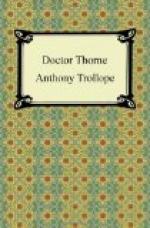THE GRESHAMS OF GRESHAMSBURY
Before the reader is introduced to the modest country medical practitioner who is to be the chief personage of the following tale, it will be well that he should be made acquainted with some particulars as to the locality in which, and the neighbours among whom, our doctor followed his profession.
There is a county in the west of England not so full of life, indeed, nor so widely spoken of as some of its manufacturing leviathan brethren in the north, but which is, nevertheless, very dear to those who know it well. Its green pastures, its waving wheat, its deep and shady and—let us add—dirty lanes, its paths and stiles, its tawny-coloured, well-built rural churches, its avenues of beeches, and frequent Tudor mansions, its constant county hunt, its social graces, and the general air of clanship which pervades it, has made it to its own inhabitants a favoured land of Goshen. It is purely agricultural; agricultural in its produce, agricultural in its poor, and agricultural in its pleasures. There are towns in it, of course; depots from whence are brought seeds and groceries, ribbons and fire-shovels; in which markets are held and county balls are carried on; which return members to Parliament, generally—in spite of Reform Bills, past, present, and coming—in accordance with the dictates of some neighbouring land magnate; from whence emanate the country postmen, and where is located the supply of post-horses necessary for county visitings. But these towns add nothing to the importance of the county; dull, all but death-like single streets. Each possesses two pumps, three hotels, ten shops, fifteen beer-houses, a beadle, and a market-place.
Indeed, the town population of the county reckons for nothing when the importance of the county is discussed, with the exception, as before said, of the assize town, which is also a cathedral city. Herein a clerical aristocracy, which is certainly not without its due weight. A resident bishop, a resident dean, an archdeacon, three or four resident prebendaries, and all their numerous chaplains, vicars, and ecclesiastical satellites, do make up a society sufficiently powerful to be counted as something by the county squirearchy. In other respects the greatness of Barsetshire depends wholly on the landed powers.
Barsetshire, however, is not now so essentially one whole as it was before the Reform Bill divided it. There is in these days an East Barsetshire, and there is a West Barsetshire; and people conversant with Barsetshire doings declare that they can already decipher some difference of feeling, some division of interests. The eastern moiety of the county is more purely Conservative than the western; there is, or was, a taint of Peelism in the latter; and then, too, the residence of two such great Whig magnates as the Duke of Omnium and the Earl De Courcy in that locality in some degree overshadows and renders less influential the gentlemen who live near them.




